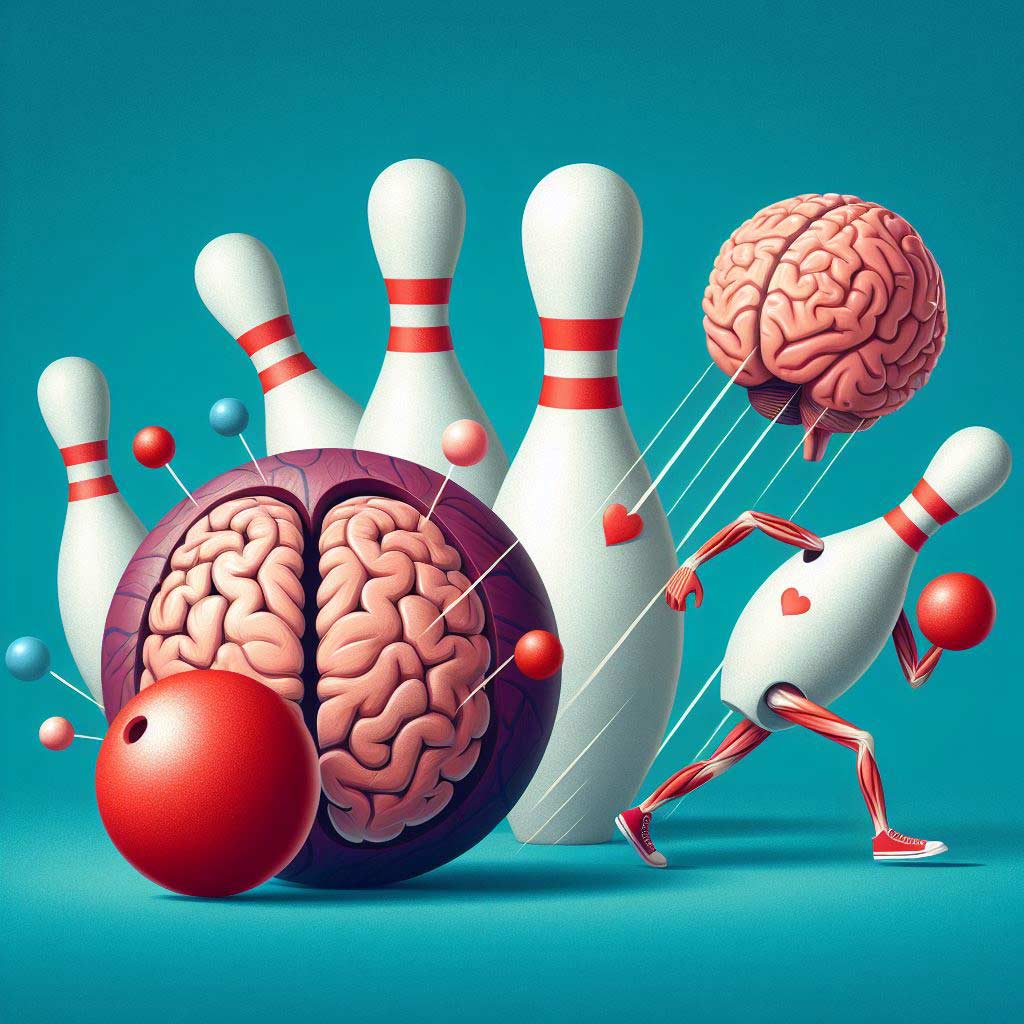Bowling is often viewed as just a fun recreational activity to enjoy with friends and family. However, research shows that bowling can provide many physical and mental health benefits beyond just having a good time.
While it may not be as strenuous as some hardcore athletic sports, bowling positively impacts the body and mind in various ways. From gentle exercise to stress relief, there are many key reasons why bowling a few games can be great for your overall health and well-being.
Physical Health Benefits of Bowling
Improves Heart Health
One of the key physical health benefits of bowling is that it gets your heart pumping. Bowling raises your heart rate and improves blood circulation, providing moderate cardiovascular exercise.
According to a study published in the Journal of Exercise Physiology Online, bowling has similar physiological effects as walking on a treadmill at 3 mph. Researchers found that 30 minutes of bowling activity burned an average of 3.6 calories per minute or around 150 calories total.
So while it may seem like you’re just leisurely rolling balls down a lane, all the movements involved – walking, bending, throwing – sustain an elevated heart rate in the fat-burning zone. The exercise from bowling a few games can support heart health and cardiovascular fitness.
Burns Calories and Aids Weight Loss
Related to the heart health benefits, bowling can help you burn calories and shed unwanted pounds.
In one hour of bowling, a 160-pound person can expect to burn around:
- 153 calories bowling casually
- 255 calories bowling competitively
- 204 calories bowling in a league
These estimates will vary based on your body weight and intensity while playing. But bowling torches calories and serves as moderate aerobic exercise.
Over time, regularly hitting the bowling alley instead of remaining sedentary can aid significantly in weight loss and maintenance. Even just a 150-calorie burn per hour adds up substantially over months and years of bowling.
Builds Muscle Strength
Beyond cardio, bowling can build muscle strength – especially in the arms, legs, and core.
Bowling uses underarm motions similar to pitching in baseball or javelin throwing. Forcefully swinging the bowling ball strengthens the biceps, triceps, shoulders, and back muscles. This muscle activation occurs even when using lighter bowling balls.
Additionally, the lunging leg motion in the bowling approach engages the quadriceps and glutes. Lastly, core engagement is required to stabilize the body during the bowling swing. The torso rotation involves works the abdominal and oblique muscles.
So while you may not end up with bulging biceps from bowling alone, over time it can lead to noticeable muscle development and strength gains.
Enhances Motor Skills and Coordination
Bowling helps enhance your overall motor skills and hand-eye coordination. Successfully bowling well requires precise movements and accuracy when aligning the ball release towards the pins.
Neurological connections are strengthened through repetitive bowling motions. Bowling integrates the visual processing center with the motor control centers for finely tuned coordination.
Studies have found bowling to improve dynamic balance, proprioception, motor sequencing, and reaction times. The sport’s heavy demands on eye-hand-foot coordination can even help those recovering from an injury regain mobility and stability.
Gentle on Joints
While bowling does provide many physical benefits, it remains relatively low-impact compared to hardcore athletic sports that involve running and jumping.
The smooth underarm swinging motion is gentle on the elbow, wrist, and shoulder joints. The lane surface is more forgiving on the knees and ankles compared to sports with quicker directional changes.
This makes bowling an appealing activity for those with arthritis, joint injuries, or wanting lower-impact exercise. Bowling can aid in recovery for certain orthopedic conditions compared to risking further injury with high-impact workouts.
Those who cannot handle heavy weights or jogging can still find an enjoyable physical activity with bowling that avoids joint strain or discomfort. Just be sure to stretch properly beforehand and use good form when bowling.
Mental Health Benefits of Bowling
Stimulates the Mind
Beyond simply physical exercise, bowling also provides several mental stimulation and cognitive benefits.
Bowling well requires substantial concentration, focus, and mental acuity. Players must calculate angles and pin positions, develop a strategy for their shot, block out distractions, and then fluidly execute this plan.
This heightened level of prolonged concentration forces the mind to work, improving mental stamina. The brain continually processes visuospatial information to aim shots and adjust strategy.
Studies note recreational bowling helps improve cognitive abilities and processing speed while delaying age-related memory loss. The mental workout from all that bowling concentration keeps the mind sharp.
Provides Social Interaction
The social nature of bowling is a major benefit for mental health. People can bowl alone, but the sport lends itself to playing with others. You can join a league, battle friends or family, or just chat with other bowlers present.
This social atmosphere gets people engaged with others face-to-face in real life. Bonding through friendly competition and conversation in the bowling alley alleviates feelings of loneliness or isolation.
For those suffering from depression, seasonal affective disorder, or mood disorders, maintaining social connections is hugely beneficial. The weekly social outing bowling provides improves overall well-being outside the game itself.
You can even turn bowling into “therapy bowls” by inviting close friends you can talk to about anything on your mind. The sport becomes a means for meaningful connection.
Builds a Sense of Community
Expanding on the social aspect, regularly bowling in a league generates a sense of community. League members see each other weekly and bond over their shared interest in the sport.
Having this positive community fosters friendships, support systems, and memories. Teammates cheer each other on and can become long-term friends. People can find “their people” in a bowling league.
The community atmosphere also creates accountability to show up and bowl your best. You don’t want to let your team down by missing a league night. This accountability motivates people off the couch out of isolation.
For aging adults especially, joining a senior bowling league provides regular fun and socialization to stay engaged. It’s a simple way to feel part of something bigger than oneself.
Boosts Mood Through Exercise
Aside from the social perks, simply bowling itself elevates mood through exercise and recreation. The physical act of bowling releases feel-good endorphins that put you in a positive mindset.
Bowling also spikes levels of dopamine in the brain. Dopamine regulates motivation and reward-driven behaviors. Striking down all the pins evokes a rush of dopamine that makes you feel accomplished and motivated to succeed.
This mood boosts from recreational bowling has therapeutic properties to combat anxiety, sadness or irritability. The sport can be a natural remedy when feeling stressed or down.
Additional Bowling Health Benefits
Accessible Sport for All Ages and Abilities
A major bonus of bowling is how accessible it is for people of all ages and physical abilities. Young children can bowl with ramps and bumpers. Older adults utilize lighter balls with finger holes for easier grip.
Those with disabilities can bowl sitting down or use adaptive equipment like bowling ball ramps. This allows wheelchair users to enjoy the sport.
Anyone can physically participate in bowling at some level thanks to these specialized accommodations. Entire families with preschoolers to grandparents can play together. The sport has near-universal accessibility.
Indoor Sport for Year-Round Play
The weather outside does not affect the ability to bowl, as alleys are indoors. This means bowling can be played and enjoyed rain or shine, winter or summer.
You don’t have to wait for nice weather to go bowling like with golf or outdoor court sports. If winter conditions have you stuck inside, bowling gets you active without braving the cold.
People can keep up their bowling hobby all year long thanks to the indoor environment. Leagues can run continually without weather disruptions.
Bonding Over Food and Drink
A fun benefit of bowling is the food and drink bonding that often takes place during or after bowling.
Many bowling alleys have attached restaurants, bars, arcades, or lounge areas. People grab beers, burgers, and appetizers as part of the bowling fun. Birthday parties feature pizza and cake.
This social bonding over food and drink before, during, or after bowling adds to the enjoyment. It also provides another opportunity for conversation and mental health benefits.
Conclusion
Bowling may appear on the surface as just an entertaining recreational activity and sport. However, research and experts have found bowling provides an array of physical and psychological health benefits.
Moderate exercise burns calories for weight loss and heart health. Strength, motor skills and balance all improve through the motions required. Mentally, bowling enhances mood, concentration, social connections, and community bonding.
Bowling is also highly accessible no matter your age or current physical ability. And as an indoor sport, bowling is available year-round regardless of weather.
So consider lacing up some shoes and rolling a few games at your local bowling alley. The health perks are certainly stacked in bowling’s favor! Just remember to stretch first and work on your aim – those pins won’t knock themselves down. Let us know if you start noticing the healthy bowling benefits in your life!
Frequently Asked Questions
How does bowling help you physically?
Bowling provides physical benefits by burning calories, elevating heart rate, building muscle strength, and improving motor skills and coordination while being low-impact on joints. The motions involved engage various muscle groups and provide moderate aerobic exercise.
Can you gain muscle from bowling?
Yes, bowling can help you gain some muscle, especially in the arms, legs, and core areas. The underarm swinging motion strengthens arm and shoulder muscles. Lunging motions work the quadriceps and glutes. The torso rotation engages abdominal muscles. Over time, bowling can lead to noticeable muscle development.
Do you get exercise from bowling?
Definitely. Bowling raises your heart rate, burns calories, and uses various muscle groups. The combination of walking, bending, throwing, lunging, and swinging provides moderate physical exercise. Just 30 minutes of bowling can burn around 150 calories.
Does bowling keep you fit?
Bowling can help keep you fit as part of an overall exercise routine. The activity provides cardiovascular, strength training, and coordination benefits. Bowling frequently can aid weight loss, muscle tone, motor skills, and heart health. While not strenuous, bowling positively contributes to fitness.
Does bowling help mental health?
Yes, bowling can provide several mental health benefits. The concentration required may improve cognitive abilities. The social nature boosts mood and combats depression. Being part of a bowling team builds community and accountability. Overall, bowling can aid mental wellbeing.
What type of benefits can be obtained from bowling?
Some top benefits of bowling include cardiovascular exercise, strength gains, weight loss, enhanced coordination, cognitive stimulation, social interaction, elevated mood, and a sense of community.
Does bowling cause muscle imbalance?
It’s unlikely bowling alone would cause major muscle imbalances. However, repeatedly bowling many games weekly could overwork one arm/shoulder without proper cross-training. It’s smart to balance bowling with exercises working both sides of the body.
Why is my body so sore after bowling?
Bowling uses several muscle groups – arms, core, legs – that may not be used in day-to-day activities. Soreness after bowling indicates you worked new muscles. This is normal at the start. As your body adapts, bowling soreness should subside. Proper stretching helps.
Can you get nerve damage from bowling?
It’s very rare, but possibly. Repeated stress on the wrist/elbow from improper bowling form could injure nerves. Nerve damage is more likely in elite bowlers bowling full-time. For the average recreational bowler, nerve issues are unlikely with good technique.





